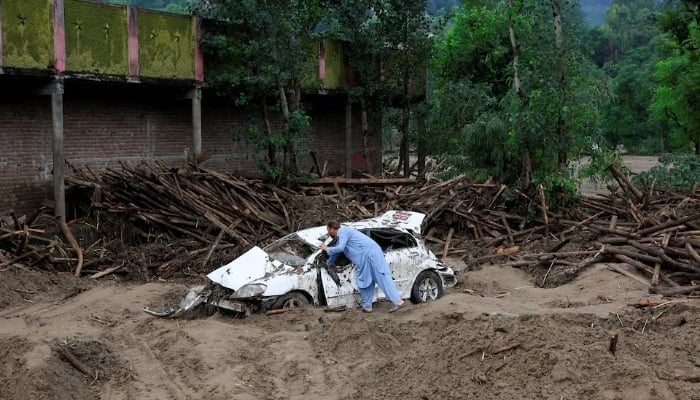The deadly Pakistan monsoon floods have claimed almost 400 lives in northern regions after five consecutive days of torrential rain triggered landslides and flash floods. Rescuers and local communities are racing against time to find survivors, while authorities warn that heavy downpours are expected to continue until the weekend.
Rising Death Toll
The National Disaster Management Authority (NDMA) confirmed that at least 356 people have died in Khyber Pakhtunkhwa province since Thursday evening. Dozens more perished in nearby regions, pushing the total death toll close to 400.
Floodwaters have swept away villages, destroyed homes, and left entire families missing under rubble and mud. Rescuers in Dalori village continued digging through stones and collapsed structures, hoping to recover survivors or the remains of those still missing.
Villagers Mourn Losses
Heart-wrenching stories have emerged from flood-stricken areas. In Buner district, 31-year-old labourer Umar Islam mourned his father, who died on Monday. Fighting back tears, he described how the disaster struck without warning.
“Our misery is beyond explanation. In minutes, we lost everything. Our lives are ruined,” he said as neighbours tried to console him.
Another villager, Fazal Akbar, called the floods “terrifying.” He recalled how mosque announcements urged villagers to begin rescue efforts themselves. “In less than 20 minutes, our village was reduced to ruins,” Akbar explained.
Relief Operations by AKDN
Amid widespread devastation, the Aga Khan Development Network (AKDN) launched large-scale relief operations across Gilgit-Baltistan, Chitral, and other mountain communities.
The Aga Khan Agency for Habitat (AKAH), AKDN’s lead disaster body, activated emergency centres in Chitral, Gilgit, Karachi, and Islamabad when the floods began. Community Emergency Response Teams evacuated more than 3,000 people, while food, tents, and emergency shelters were distributed.
Nine Disaster Assessment Response Teams conducted rapid surveys in affected areas, and community volunteers began repairing water lines, irrigation channels, and damaged roads under difficult conditions.
Read: Karachi Urban Flooding Leaves City Powerless, PMD Forecasts More Rain
Rescue and Infrastructure Repair
In Diamer, Village Emergency Response Teams rescued stranded residents and tourists. In Ghizer and Baltistan, the Aga Khan Rural Support Programme (AKRSP) helped restore damaged roads and water infrastructure.
Healthcare services also remain critical. The Aga Khan Health Service, Pakistan, deployed medical workers on 24-hour duty. In Punial, a three-day medical camp treated more than 380 patients, while mobile health teams visited remote households to provide maternal care and hygiene counselling.
Commitment to Long-Term Recovery
Responding to an appeal from Gilgit-Baltistan Chief Minister Haji Gulbar Khan, AKDN pledged long-term support. This includes rehabilitation of schools, restoration of health facilities, and solar retrofitting for energy resilience. Plans also cover protection infrastructure to reduce future flood risks, distribution of livestock inputs for farmers, and provision of medical equipment.
National Toll Since June
According to the NDMA, more than 700 people have died nationwide since the monsoon rains began on June 26. Nearly 1,000 others have been injured. The current season is expected to continue until mid-September, raising fears of further casualties.
Landslides and flash floods are common during Pakistan’s monsoon, which typically lasts from June to September. However, climate experts warn that the scale of recent disasters highlights the country’s increasing vulnerability to climate change.
Climate Change and Vulnerability
Pakistan ranks among the world’s most climate-vulnerable nations. Extreme weather events are becoming more frequent and destructive, leaving fragile communities with little time to recover between disasters.
In 2022, catastrophic monsoon floods submerged one-third of the country, killing around 1,700 people and displacing millions. The current disaster has revived fears of another large-scale humanitarian crisis if rains persist in the coming weeks.
Urgent Need for Preparedness
The Pakistan monsoon floods have once again underlined the urgent need for better preparedness, stronger infrastructure, and international support. While rescue teams and community volunteers continue risking their lives, authorities warn that the worst may not be over yet.
As torrential rains show no sign of stopping, vulnerable communities remain on edge. The struggle now is not only to save lives but also to ensure long-term resilience in the face of climate-driven disasters.
Follow us on Instagram, YouTube, Facebook,, X and TikTok for latest updates
